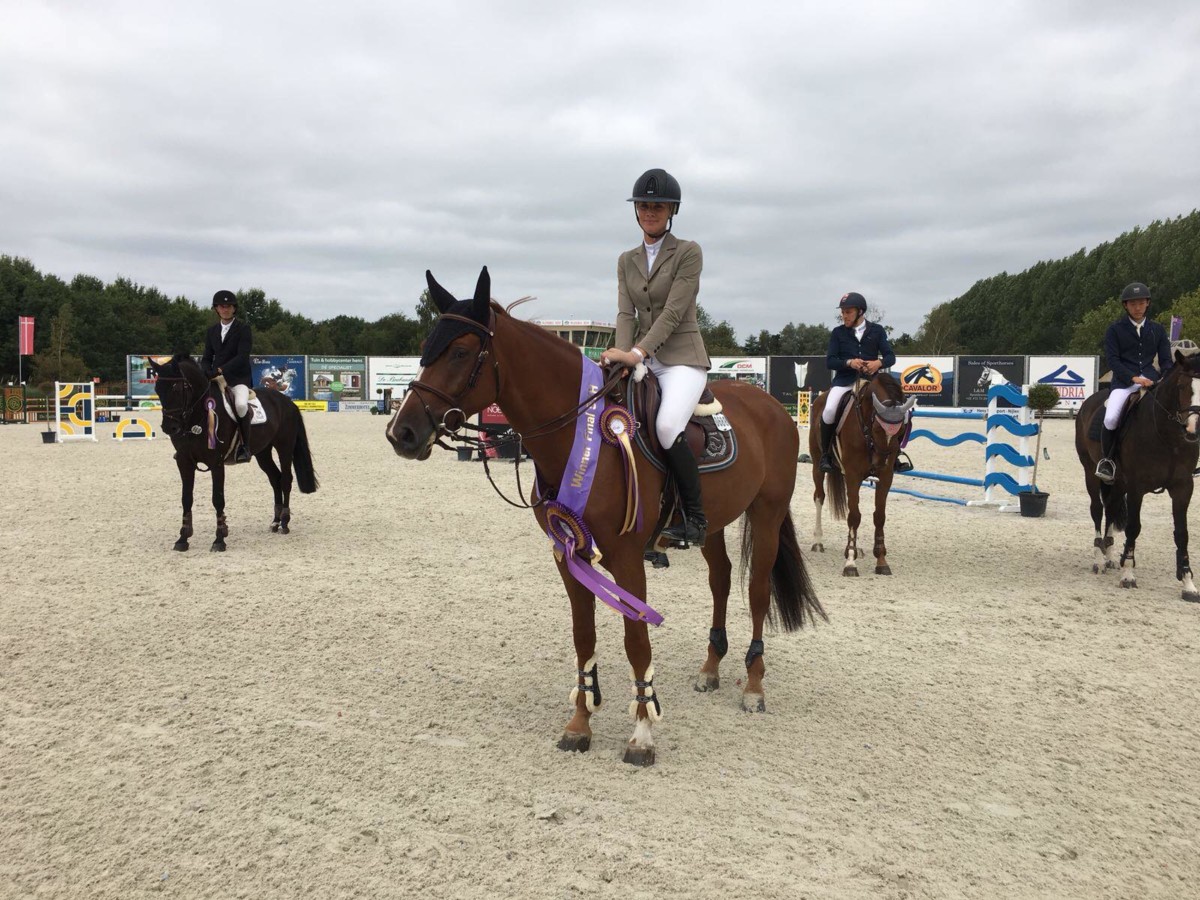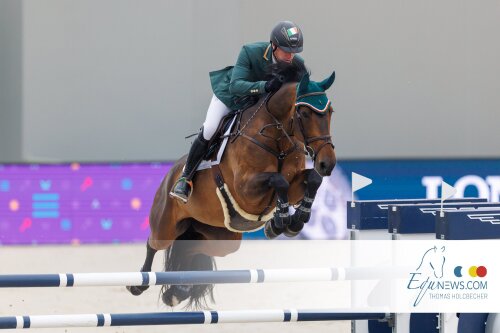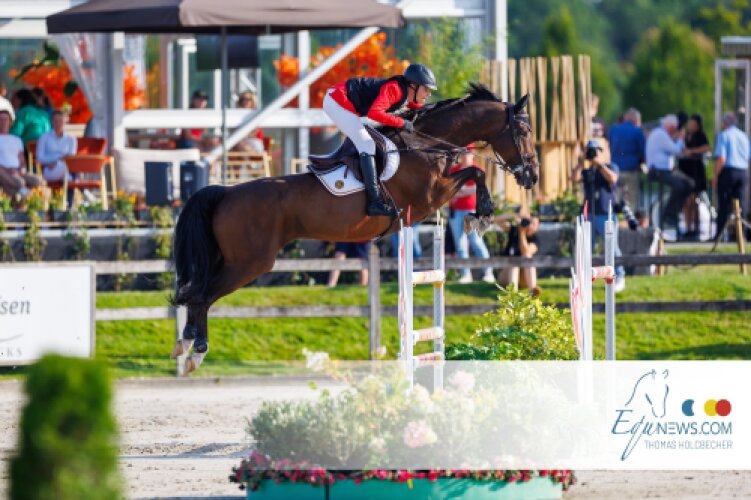"The last few weeks have been very difficult for me and that is why I am only now coming out with my story," the rider starts. "We had gone down to Oliva at the beginning of January to compete there with ten horses. Oliva was super and our horses jumped great. I think this competition is one of the best to prepare your horses for the outdoor season. Our horses jumped to different placings and we were looking forward to continue our 'Spanish adventure' at the Sunshine Tour. It would be the first time for me to participate in the Sunshine Tour".
"The first two weeks were fantastic and all the horses jumped well. During the third week, on February 26, one of my horses developed a fever. We contacted the organization and FEI veterinarians about the situation and my horse was placed in isolation. During that weekend, she made between 39 and 40 degrees of fever. I feel the need to tell my story as I notice all kinds of "cowboy stories" circulating that I want to debunk. The days and weeks that followed were emotionally exhausting".
Axelsson wrote the letter below to the FEI:
On Monday, March 1, the FEI announced the cancellation of events in continental Europe. An exception was made for specific competitions, including the Sunshine Tour. But not without conditions: Absolutely no new horses were allowed to enter, and no positive cases of EHV-1 were to be confirmed.
Before that, on Monday, February 22, the horses that had participated in the Spring Tour in Valencia since February 1 had been blocked in the FEI database. However, there was one problem that could not be solved by the competition blocking: Several horses that had competed in Valencia - many of them all the way up to February 7 - had already left the venue and moved on to the Sunshine Tour where they were still jumping on February 22. One horse that competed in the Sunshine Tour did not leave Valencia until February 13. During the third week of the tour, horses with competition blocks were transferred to isolation stables.
Agnetha Z arrived on the Sunshine Tour on February 6, from the Netherlands, and joined the rest of my horses that had come to Vejer de la Frontera from Oliva Nova. Like all my other horses, she was healthy upon arrival. When she left, she was seriously ill.
On February 26, Agnetha Z was transferred from the competition grounds to the isolation stables because she had developed a fever. By then, there were several other horses in the isolation room - some due to the competition blockade imposed by the FEI and others due to the fact that no new horses were allowed on the grounds.
During the first, short examination of Agnetha Z, the vet stated that she was 98% sure this was a case of piroplasmosis. Due to the situation in Valencia, I asked the vet if she did not think it was better to test for EHV-1: Just to be on the safe side. The vet replied that she did not think an EHV-1 test was necessary, referring to her theory of piroplasmosis. During the first night, Agnetha Z had a temperature of around 39.8. The second night it escalated to 40.5. Normally, at least in my opinion, a horse with as much fever as this, should be monitored very closely - but we could hardly even reach the vet. On Monday 1st of March, after continued requests from my side, the vet - now listed as the new Show veterinarian - eventually agreed to test Agnetha Z for EHV-1 as well as for piroplasmosis. Both tests later came back negative.As my other horses were scheduled to travel back to Holland at the beginning of that week, and the show vet insisted that this was a case of piroplasmosis and not EHV-1 - I drove back with them as planned and left my groom in charge of Agnetha until she was cleared for transportation. As it was presented to me, Agnetha could most likely travel home on Wednesday or Thursday that week - as soon as we had the test results. We had already received Agnetha Z's health papers from the show office on Sunday 28th of February.
However, in the morning of Thursday the 4th of March, my groom alerted me that Agnetha Z's condition had taken a turn for the worse: She dragged her hind legs when walking and had not been urinating. As urine retention is another clinical sign of EHV-1, our concerns over Agnetha Z's condition grew. Additionally, there were more horses in the isolation area that had arrived after developing fever. One of them belonged to an acquaintance of mine, Tom Martens. As the show vet that morning did not show up in the isolation area to check on the horses, Martens ended up requesting her services by phone.When the show vet finally arrived around 2 PM, my groom was present - as was Martens. Agnetha Z was unstable in her coordination and movements, but the show vet was of the opinion that this was due to the hard and slippery asphalt surface she was being showed on. Moving over to a soft surface, it was obvious that something was not right. However, the show vet disputed this was anything neurologic. At this stage, Martens had called for his colleague Vincent Voorn to join him in the isolation area. Dr. Frederik Bruyninx of Belgium also came, as did FEI Athlete Representative Pedro Veniss. As it was clear that the show vet did not want to treat this as a case of EHV-1, Dr. Bruyninx was by Agnetha Z's owner requested to give her the veterinary care she needed.In the afternoon of Friday 5th of March, the organisers informed other athletes per WhatsApp that the second test on Agnetha Z had come back negative on EHV-1 - despite the FEI concluding that the test result was inconclusive. This inconclusive result, together with a second horse having developed mild neurological signs and a slightly elevated temperature, eventually contributed towards the FEI that same day cancelling the tour.From Friday 5th of March to Saturday 6th, Dr. Bruyninx stayed with my groom and Agnetha Z the whole night. As Agnetha Z's condition worsened, the two of them decided to move her to another box where there were hooks in the ceiling installed to help hold her up. On that Friday, a shipment from Belgium with the necessary medication had arrived - as well as from Valencia - so during the night, Dr. Bruyninx administered this to Agnetha Z to try to help her. The show vet was not present at all that night.
On the Saturday, the situation had become very uncomfortable as the FEI veterinary delegates no longer were allowed access to the venue by the organisers. We decided that it was in Agnetha Z's best interest to move her to a clinic where she could get the necessary veterinary care. Dr. Bruyninx and my groom arranged so that the back of the two-horse truck was made into a box and decided to try to travel Agnetha Z this way. When Dr. Bruyninx and my groom arrived at the clinic with Agnetha Z, she was refused entry due to the symptoms she was showing. At this stage, the organisers had sent a letter to the FEI that stating that we had left the showground with a sick horse and without the necessary health papers. This was however incorrect, as I had received Agnetha Z's health papers at the show office when I was departing with the other horses earlier that week. So, on the one hand, the organisers and the show vet were arguing that Agnetha Z was negative to EHV-1 but on the other hand they alerted the FEI that she was too sick to travel and did not have the required health papers.
In the aftermath of the FEI's decision to cancel the event, the organisers sent out a statement dated 9th of March, arguing that EHV-1 and EHV-4 at no time had been detected at their facilities. There was no reference to the fact that the FEI had deemed Agnetha Z's latest test result to be inconclusive. In their statement, the organisers identified Agnetha Z by name and shared her medical information - without the consent of either her owner or me. The organisers also incorrectly referred to how Agnetha Z had been placed in an intensive care unit. There was no such unit in the isolation stables, and Agnetha Z never received intensive care from the show vet. Later on, there has been no communication from the organisers to follow-up on the positive test returned by Agnetha Z after she came back home from the Sunshine Tour.
While Agnetha Z was in the isolation area, there were several concerns about the veterinary resources: It was not enough for one horse, let alone in a worst-case scenario for the entire horse population on the showground. For example, Dr. Frank van Hoek and Dr. Frederik Bruyninx both had to assist in order to get Agnetha Z the necessary veterinary attention. Another concern was the lack of necessary equipment and medication. For example, when Dr. Bruyninx wanted to put Agnetha Z on fluids, there was not a catheter available. We also had to organise the correct medication for Agnetha Z ourselves, which Dr. Bruyninx administered to her.In my opinion, the whole situation in the isolation area was also not in accordance with the FEI Veterinary Regulations. There was a mix of horses that had come in with fever, horses that were waiting to travel to their home countries as well as nearby stabled carriage horses driving through. Until Friday the 5th of March, people could enter and leave the isolation area as they pleased - there was no security checks. Both I and my groom had concerns over what we thought to be a too relaxed attitude towards the biosecurity from the VSM as she moved between Agnetha Z and other horses in the isolation area with the same clothing, and without disinfecting.
A lot of mistakes have been made, and Agnetha Z is one of the horses that has ended up paying the price. Since Agnetha Z's arrival from the Sunshine Tour and to this date, she has been in a clinic in Belgium. She has been severely ill and has tested positive to EHV-1. While the PCR tests now are negative, she is still positive in the blood. Six of my other horses also returned positive EHV-1 bloodtests on Saturday 27th of March, as did three horses from one of my students. As well known by now, many other horses have also tested positive after coming home from the Sunshine Tour.
I would sincerely had hoped that the organisers - known to host one of the very best events in the world - would have acted more professionally, both prior to and after the cancellation. The health and welfare of our horses should always remain the no. one priority, everything else is secondary. I hope my experiences can serve as an input to the FEI's review of the EHV-1 outbreak so that what has happened won't be repeated.
Source: aastables



